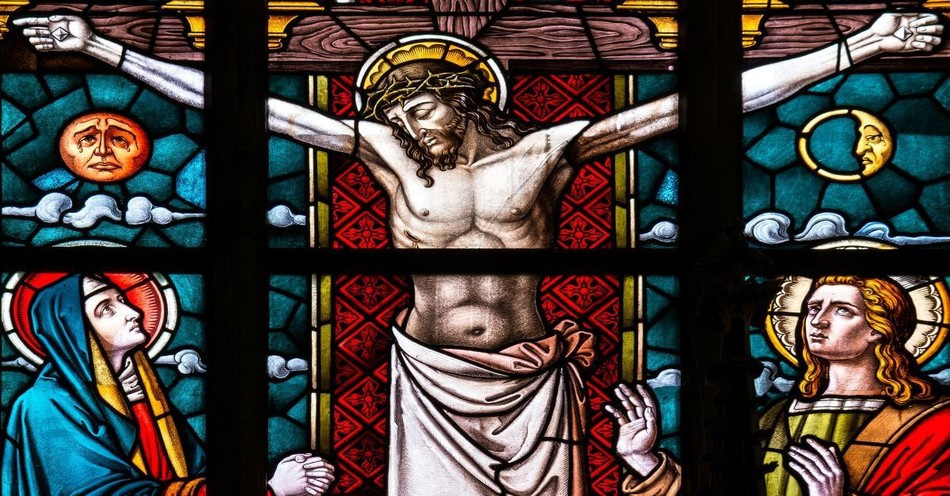Origin of Hail Mary Prayer
The Hail Mary prayer stems from two passages in the gospel of Luke. The first one, found in Luke 1:28, says, “Hail, full of grace, the Lord is with you!” This was mentioned by the angel Gabriel when she greeted Mary; this event is also known as the Annunciation. The second passage can be found in Luke 1:42, and it says, “Blessed are you among women, and blessed is the fruit of your womb!” These words were said by Elizabeth when she visited Mary and greeted her. To many Catholics, this event is also called the Visitation.
Though the two verses are from the same book in the Bible, these lines were not put together until about the 11th century. According to the Catholic Encyclopedia:
In point of fact, there is little or no trace of the Hail Mary as an accepted devotional formula before about 1050. All the evidence suggests that it took its rise from certain versicles and responsories occurring in the Little Office or Cursus of the Blessed Virgin which just at that time was coming into favor among the monastic orders. Two Anglo-Saxon manuscripts at the British Museum, one of which may be as old as the year 1030, show that the words ‘Ave Maria’ etc. and ‘benedicta tu in mulieribus et benedictus fructus ventris tui’ occurred in almost every part of the Cursus, and though we cannot be sure that these clauses were at first joined together so as to make one prayer, there is conclusive evidence that this had come to pass only a very little later.
In its early years, the prayer was only composed of those two verses (Luke 1:28 and Luke 1:42) and was called the “Salutation of the Blessed Virgin.” Later on, the second half of the prayer was added. Back then, it was published in Latin, with the title being “Ave Maria.”
The Ave Maria, however, was only officially finalized when the Catechism of the Council of Trent was published. There, it was referred to as the “Angelical Salutation.” Later on, the prayer was incorporated into the Roman Breviary of 1568. Since then, it has been in use widely and is known by a huge majority of Catholics.
Hail Mary Prayer
Hail Mary, full of grace,
the Lord is with you.
Blessed are you among women,
and blessed is the fruit of your womb, Jesus.
Holy Mary, Mother of God,
pray for us sinners,
now and at the hour of our death.
Amen.
The Hail Mary in Latin
Ave Maria, gratia plena,
Dominus tecum,
benedicta tu in mulieribus,
et benedictus fructus ventris tui Iesus.
Sancta Maria mater Dei,
ora pro nobis peccatoribus,
nunc, et in hora mortis nostrae.
The Hail Mary in Spanish
Dios te salve, Mara,
llena eres de gracia,
el Seor es contigo.
Bendita tu eres entre todas las mujeres,
y bendito es el fruto de tu vientre, Jesus.
Santa Maria, Madre de Dios,
ruega por nosotros, pecadores,
ahora y en la hora de nuestra muerte.
Amen
Orthodox Hail Mary Prayer
The Hail Mary, also known as Hail Mother of God, The Angelic Salutation, or Ave Maria (Latin title used by Roman Catholics) is a traditional Christian prayer asking for the intercession of the Holy Virgin Mary known in the Orthodox Church as Theotokos (meaning "God-bearer" or "Birth-giver to God"), the mother of Jesus Christ. The Hail Mary is used by Orthodox Christians (Eastern Orthodox) and Oriental Orthodox. It is usually sung three times at the end of Great Vespers during an All-Night Vigil, as well as many times in the course of daily prayer.
Theotokos Virgin, rejoice, Mary full of grace, the Lord is with You.
Blessed are You among women, and blessed is the fruit of Your womb,
for You have borne the Savior of our souls.
Meaning of Hail Mary Prayer
The Catechism of the Council of Trent breaks down the Hail Mary prayer into two parts when defining what it means. This is what the Catechism says about the first part:
The first part of the Angelical Salutation. When we say by way of prayer: ‘Hail Mary, full of grace, the Lord is with thee, blessed art thou among women,’ we render to God the highest praise and return him most grateful thanks, because he accumulated all his heavenly gifts on the most Holy Virgin ; and to the Virgin herself, for this her singular felicity, we present our respectful and fervent congratulations.
And this is the description in the Catechism of the second part:
To this form of thanksgiving the church of God has wisely added prayers to, and an invocation of, the most holy Mother of God, by which we piously and humbly fly to her patronage, in order that, by interposing her intercession, she may conciliate the friendship of God to us miserable sinners, and may obtain for us those blessings which we stand in need of in this life and in the life to come. Exiled children of Eve, who dwell in this vale of tears, should we not earnestly beseech the Mother of mercy, the advocate of the faithful, to pray for us? Should we not earnestly implore her help and assistance?
Nowadays, the Hail Mary remains to be a very important prayer for Catholics all over the world. It is a great expression of love for the Virgin Mary using words from Scripture itself. The petitions in the final part also serve as a beautiful prayer to ask for her help in times of need.
Importance of Mary in Christianity
In the Catholic faith, Mary is a key person, and her life shows the way the Heavenly Father works in people’s lives as well. Mary is a very simple person living a very ordinary life; despite that, God still called her to play a great role, which is to bear Jesus Christ in her womb.
As it sounds, it really was quite a difficult task. Imagine being the mother of the Son of God? What’s more, during that time, women were not seen as equal to men in society. Moreover, when Jesus was born, the king at the time, named Herod, issued a decree ordering the killing of infants in his kingdom. With that, Mary had to flee from her hometown to keep her child safe.
However, enduring all those trials, Mary was faithful and remained committed to the role God prepared for her. She was able to bring to this world God’s only Son.
There are three key values that Catholics can learn from Mary, fully practiced by her in the way she lived her life. As we are taught these values, let us aspire to also practice them in our daily lives, manifesting these values in how we deal with others.
1. The Value of Humility
Being humble is one of the key fundamental values a Catholic should have. The act of receiving Christ is, in itself, an act of humility. We can see in Mary’s life that we ought to avoid selfishness and pride. Even being the mother of Jesus Christ, she did not use this privilege to assert power and gain unfair advantages. Instead, she stayed humble as she kept on serving God.
2. The Value of Simplicity
We can see that Mary lived a very simple life. Even with the kind of favor God bestowed upon her, she accepted it humbly and graciously. This is unlike our world today, which glamorizes material wealth. Now, there’s nothing wrong with enjoying the fruits of our labor; it only becomes a problem when these things become obsessions that distract us from God.
Simplicity encourages us to depend more on God and to use His standards to measure our own lives. It makes us realize that there is more to life than chasing worldly aspirations. Also, living simply allows us to understand the situation of the needy. God has a heart for those in need, and we should aim to have the same.
3. The Value of Charity
At the core of everything that Mary did is charity. For one, being a mother is in itself a charitable pursuit, requiring her to be generous for the sake of her child.
In the Catholic faith, the words “love” and “charity” are often used interchangeably, and for good reason. Practicing charity is a kind of love, and when we display charity in our lives, we show that we love God above anything else. For this reason, all other Catholic values ultimately point back to the value of charity. And through being charitable, we also manifest the other fruits of the spirit, such as mercy, peace, and joy. The acts of sacrifice done for the sake of charity always serve to nourish our souls.
Article by Pearl Dy.
Image credit: pexels.com
This article is part of Christianity.com's prayer answers including famous, topical prayers and information about the power of prayer. Find more related articles in the collection of prayers below:
The Serenity Prayer
The Lord's Prayer
Morning Prayers
Prayers for Healing
Thanksgiving Prayers
Advent Prayers
Christmas Prayers
Prayers for Peace
Prayers for Protection
Prayers for Strength
Praying in the Spirit
This article is part of our prayer resources meant to inspire and encourage your prayer life when you face uncertain times. Remember, the Holy Spirit intercedes for us, and God knows your heart even if you can't find the words to pray.
Prayers for Healing
Morning Prayers
Prayers for Family
Prayers for Surgery
Prayers for Strength
Night Prayers Before Bed
Prayers for Protection
The Lord's Prayer: Our Father
Now available is our new Daily Prayer devotional! An easy way to start your day with prayer: read today’s prayer and sign up to receive it by email.









